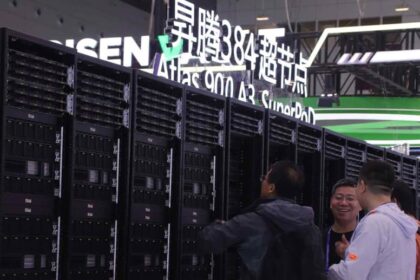Why plug and play AI is taking off in China
A new wave of plug and play AI is moving through China, from hotel lobbies to factory floors and local service counters. Backed by large cloud platforms, a national push to digitize industry, and a growing supply of low cost large language models, tools that once required teams of engineers are arriving as boxed appliances and browser dashboards. Companies type a request in plain language and the system books a room, plans a shift, or drafts a report. The appeal is speed, lower entry costs, and results that fit into daily work.
- Why plug and play AI is taking off in China
- From hotels to hospitals, what plug and play looks like
- Cheap models and the DeepSeek effect
- All in one AI machines and data security tradeoffs
- Agent platforms, MCP, and the quest for a common standard
- The policy and regulation backdrop
- Can small businesses afford it
- How China compares with other regions
- Risks, upgrades, and what buyers should ask
- The Bottom Line
China has set a high bar for adoption. Under the AI Plus strategy, policymakers want AI embedded across 90 percent of major industries by 2030. The focus is practical utility. Hotels, hospitals, automakers, and government offices are installing out of the box tools that can read documents, answer questions, and act on behalf of staff. These systems are built on large language models, the same general technology behind popular chatbots. In plain terms, a model is trained on a wide set of data so it can predict what text should come next. With the right safeguards and integrations, it can summarize records, search internal files, or trigger a workflow.
Plug and play AI refers to prepackaged hardware and software that is quick to set up. Think of an all in one machine running a vetted model, paired with a simple console that connects to company data and common tools. Instead of custom code, business users rely on natural language prompts and a catalog of reliable actions. Scale, a large domestic market, and rapid iteration give Chinese vendors an advantage. Major cloud providers have built strong infrastructure and are competing to make these solutions as simple as possible for customers that lack deep technical teams.
From hotels to hospitals, what plug and play looks like
In hospitality, digital concierges are greeting guests on screens and in messaging apps. One chain’s service, powered by a domestic cloud provider, can handle more than 30 routine front desk tasks. It checks room availability, explains late checkout rules, suggests nearby restaurants, and forwards special requests to staff. The system runs on a large language model tuned for hotel operations, so it speaks in a friendly tone, keeps logs, and respects privacy controls set by the property.
Automakers use similar tools to deflect customer service calls and support online sales. A large joint venture has shown that a well trained bot can answer warranty questions, schedule maintenance, and route complex cases to human agents. Government offices have adopted assistants to parse applications, retrieve archived records, and generate drafts of official replies. In hospitals, intake chatbots can collect symptoms, check insurance status, and prepare notes for doctors, while back office systems compose discharge summaries and billing codes. These deployments aim to reduce wait times, cut repetitive paperwork, and help staff focus on judgment and care.
Sales are rising where data is sensitive and workflows are repeatable. Public agencies and medical institutions value local control and audit trails, so they often choose systems that keep data inside their own networks. Vendors that provide clear integration plans, training, and on site support are winning contracts. The strongest results come when teams redesign processes with AI in mind rather than simply dropping a chatbot into a legacy queue.
Cheap models and the DeepSeek effect
Model economics are shifting quickly. A homegrown startup’s reasoning model, released as an open project and updated at a quick pace, has drawn wide interest for strong performance at a fraction of the cost of many Western systems. Within weeks of its public launch, downloads soared, reportedly crossing 100 million in a month, and hundreds of companies began testing or integrating it. Large cloud providers moved fast to host the model, while established internet firms plugged it into consumer apps. The momentum pushed rivals to refresh their strategies and publish more research, including open source options.
Lower cost models are changing how companies deploy AI. If a capable model runs on modest hardware, firms can consider running it on premises or using more instances to handle bursts of demand. That approach reduces reliance on the most advanced chips, which remain in short supply. It also cuts inference bills, a major budget line for any scaled AI service. Many industry watchers expect businesses that build AI agents in China to reach profitability around 2026, with prices and performance improving together. The trend is fueling growth for application builders, not just model makers, since a cheaper foundation frees budgets for integration, security, and support.
All in one AI machines and data security tradeoffs
One of the fastest growing categories is the all in one AI machine. These appliances arrive with vetted models, a management console, and connectors for files, databases, and messaging tools. The device sits inside a company’s network, so sensitive data never leaves the premises. Latency is low because inference happens locally. For industries that lack large IT teams, the promise is convenience. Unbox the machine, connect it to corporate systems, pick an approved model, and start testing with real tasks.
The approach has limits. Models improve rapidly and new safety tools appear often, which means appliances may need frequent software updates or even hardware refreshes. Buyers must plan for upgrade cycles, staff training, and vendor support. The choice between an on premises box and a cloud service is a risk and budget decision. Many firms end up using both, keeping sensitive workloads in house and sending less sensitive tasks to the cloud. Regulated industries like health care, finance, and public services are the most likely to choose local hardware for the most sensitive data.
- What these machines do well: keep data under local control, reduce latency, simplify pilots, and allow tailored integrations.
- What to watch: upgrade costs, model drift over time, vendor lock in, and the need for clear incident response if an output is wrong.
Agent platforms, MCP, and the quest for a common standard
Agent platforms let enterprises embed digital staff into daily workflows. Rather than answering one question at a time, an agent can plan a multistep task, call tools like search or forms, check whether results look correct, and hand off to a person when needed. In contact centers, an agent drafts responses and updates records. In operations, one agent can coordinate scheduling, inventory notes, and shift handovers. The goal is fewer clicks and less rework.
Connecting agents to the outside world is easier when everyone speaks a common language. A new protocol known as the model context protocol, or MCP, is gaining support from both Western and Chinese tech firms. It acts like a universal socket for tools. If a map provider, a document platform, or a payment service publishes an MCP server, any model that supports MCP can call those functions without custom glue code. That makes building AI apps feel more modular and reduces brittle one off integrations.
At a major developer conference in April, Baidu chairman Robin Li framed the shift toward standardized agents with a simple analogy.
Right now, developing agents based on MCP is like building mobile apps in 2010.
The protocol is still young. Some MCP servers lack documentation or expose too few functions to be useful. The largest platforms still control access to high value services and can change policies. Security and reliability need careful attention, especially when agents trigger actions in the real world. Even with these hurdles, developer momentum is real. Support from model providers, code editors, and cloud platforms is turning MCP into a shared foundation for agent ecosystems.
The policy and regulation backdrop
China’s regulators have built a detailed rulebook for algorithms and synthetic content. Rules for recommendation systems arrived in 2021, followed by deep synthesis safeguards in 2022 and draft measures for generative AI in 2023. Developers must register models and services, publish basic information about how they work, and run security self assessments. The Cyberspace Administration of China leads this effort. The method is iterative, focused on categories like recommendation engines, face synthesis, and text generators, with the expectation that experience from these areas will inform a broader national AI law.
Data governance drives many deployment choices. Enterprises that handle personal, financial, or health records often prefer systems that keep data inside a local network. Vendors selling overseas must adapt to local privacy laws, content rules, and language needs. Chinese companies are expanding into Southeast Asia and the Middle East with localized models, regional data hosting, and features that reflect local regulations. Success abroad requires ongoing compliance, strong documentation, and guarantees about where data lives and who can access it.
Can small businesses afford it
Large chains in food service or retail can justify investments in AI that optimizes labor, inventory, and customer care. Smaller shops often see a different picture. Up front costs feel high, technical steps are unfamiliar, and staff worry about errors. Owners want tools that just work, without layers of configuration. Many are also waiting for clearer proof of savings in daily operations, not just in pilot projects.
The market is responding with lighter options. Subscription appliances bundle hardware, software, and updates. Cloud services offer pay as you go access to models with strict data controls. Industry templates reduce setup time. Local integrators provide training and on call support. Grants and procurement programs can help, but the deciding factor is still whether a system saves time or drives new revenue with minimal friction. The tools that win in this segment will be easy to deploy, easy to support, and priced for daily use.
How China compares with other regions
Europe’s strategy emphasizes practical industrial applications. Manufacturers want AI that improves quality control, maintenance, and scheduling with short payback periods. Rather than spending heavily to build giant foundation models, many European firms focus on the application layer and structured data. Regulation is moving quickly, with the EU AI Act seeking consistent rules for risk, transparency, and oversight. The priority is to deploy systems that are auditable, secure, and compliant inside complex value chains. Many companies still struggle to scale pilots, which places a premium on easy integration and strong vendor support.
Across the Asia Pacific region, health care shows both promise and friction. AI can aid diagnostics, personalize care plans, and help overstretched staff, yet adoption is slowed by privacy concerns, fragmented systems, and a shortage of AI skills. Countries with robust digital infrastructure and clear guidance, including China, Japan, and South Korea, are moving faster, while others lag due to limited investment and inconsistent standards. Cost remains a barrier for smaller hospitals, which is why plug and play products and pay as you go models are attractive when paired with training and clear safeguards.
The United States and China are also drawing different maps for AI growth. Washington is prioritizing domestic semiconductor capacity, private sector innovation, and export controls for advanced chips. Beijing is promoting international cooperation on standards and safety while building large domestic infrastructure. Hardware supply remains a chokepoint for everyone, with Taiwan’s fabrication plants central to advanced chips. Energy is another constraint, given the power and water needs of data centers. China’s grid mix, which includes hydropower and nuclear assets in some regions, is being factored into data center planning. Efficiency gains and cleaner energy will shape where and how quickly AI workloads grow.
Energy and heavy industry offer a lens on the next phase. AI enabled digital twins, smarter controls, and predictive maintenance can improve the economics of low carbon technologies like hydrogen production and storage. That approach reduces downtime, balances power demand, and accelerates materials discovery for better catalysts. The same recipe applies across Chinese factories that want to upgrade processes without wholesale replacement of existing equipment.
Risks, upgrades, and what buyers should ask
Plug and play does not mean set and forget. Models can hallucinate, regulations change, and real world data drifts over time. Vendors may update models, swap default settings, or change terms. Appliances must be patched and sometimes replaced. Security reviews are essential, especially where agents can trigger actions. The most successful projects set clear guardrails, define when a human must review output, and measure return on investment in concrete metrics like ticket resolution time, error rates, or sales conversion.
- What data does the system train on and how is sensitive information protected
- Can the model run locally and in the cloud, and who controls model updates
- How are prompts, outputs, and logs stored and audited
- What tools can the agent call and how are permissions managed
- How fast can we roll back a model or configuration if quality drops
- What does vendor support include, and what is the upgrade schedule and total cost of ownership
- How will we measure impact, and what baseline will we compare against
The Bottom Line
- China is pushing plug and play AI into mainstream business with a national AI Plus drive to reach most major industries by 2030.
- Hotels, hospitals, factories, and public offices are adopting digital concierges, customer bots, and document assistants to cut routine work.
- Lower cost domestic models, including open releases, are speeding adoption and reducing reliance on top tier chips.
- All in one AI machines appeal to sectors that need local data control, but they introduce upgrade and support tradeoffs.
- Agent platforms are maturing, and a shared protocol called MCP is emerging to standardize tool access across models and apps.
- Chinese rules for algorithms and synthetic content require registration and security reviews, shaping how products are built and sold.
- Large firms are moving first, while small businesses want cheaper, simpler tools with strong support and clear returns.
- Europe emphasizes application level impact and compliance, APAC health care adoption is uneven, and the United States focuses on chips and private sector scale.
- Successful buyers define guardrails, track measurable outcomes, and plan for regular model and hardware updates.












